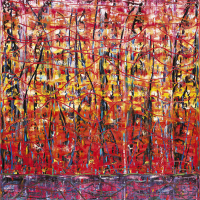39. MICHAEL JOHNSON

Michael Johnson, nowadays a veteran Australian Abstract painter, began painting in the late 1950s. A graduate of Sydneys Julian Ashton School, he moved to London in 1960 and only returned to Australia for two years in 1967 before leaving for New York in 1969. His 1967 exhibition at the Central Street Gallery and his inclusion the following year in the exhibition The Field, however, confirmed his position as a leading practitioner of Abstraction in Australia.
Johnsons path to this point was a familiar one for many Australian artists of the period. Youthful interest, confirmation through study and work experience in the field (in Johnsons case, in the design department of Lintas Advertising in the company of Brett Whiteley), travel, years spent away from Australia, exposure to all the worlds great historical art as well as acquaintance with many contemporary artists, and a return to Australia at the moment when theory, experience, ambition and ability crystallise into work that the artist can call his own.
The distinctive geometric abstractions he produced at this time are characterised by their refined use of colour and their scale. The artist could call on a depth of understanding of the most recent developments in international art. In particular Johnsons work at this time recalls the work of Bauhaus theorist and colour specialist Joseph Albers (1888-1976) as well as the eminent, cerebral New York abstract painter Marc Rothko (1903-1970). Sharp, richly coloured blocks and lathes are placed rhythmically across a field of colour, sometimes in panels of low relief, at other times crossing the boundaries of the composition. The slight shadows and variations of textures caused by these spatial incursions enrich the composition by adding a further dimension of moderation and resonance.
Later, the process of refinement, adjustment and investigation driven by Johnson through the 60s and 70s brought him, in the early 1980s to a painting technique that was uniquely his, and for which he became known throughout Australia. His paintings were also highly successful with curators, critics and collectors this positive criticism and collectability saw Johnson became one of the most in-demand artists of the 1980s. The most important collectors in Australia, the National Gallery of Australia, Canberra; the Art Gallery of New South Wales, Sydney and the National Gallery of Victoria, Melbourne, all acquired paintings in 1967-68, and now his work was being acquired by the most significant private corporate collections as well.
Vermilion 1995 embodies all of the characteristics for which the artist is now well-known. The broad field and bands animated by rhythmic patterns of line and detail that were the basis of his work in the 60s have become organic. The rigid geometries are gone, but the crisp character and compositional control remain. Spatial depth is the main beneficiary of Johnsons later work. All of the other components that were present in 1968, especially the rich colour, are still in play. Vermilion consists of a large field of red, slashed by black and blue strokes. A lesser central band of yellow emerges from the middle distance. As the field progresses upwards it passes through a minor incandescent pink area before terminating in a black, indistinct upper border. The whole rests on a blue lake with the red field reflected. Fine strands of green, consisting of paint squeezed directly from a tube, moderate the sharpness of the horizon line while the faint rose pink colour of the minor band in the upper region is repeated in 3-4 vaguely defined rose pink vertical posts, recalling Jackson Pollocks (1912-1956) Blue Poles 1952,1 placed at intervals across main field.
Footnotes
1. Acquired by the National Gallery of Australia, Canberra in 1973
Timothy Abdallah BA